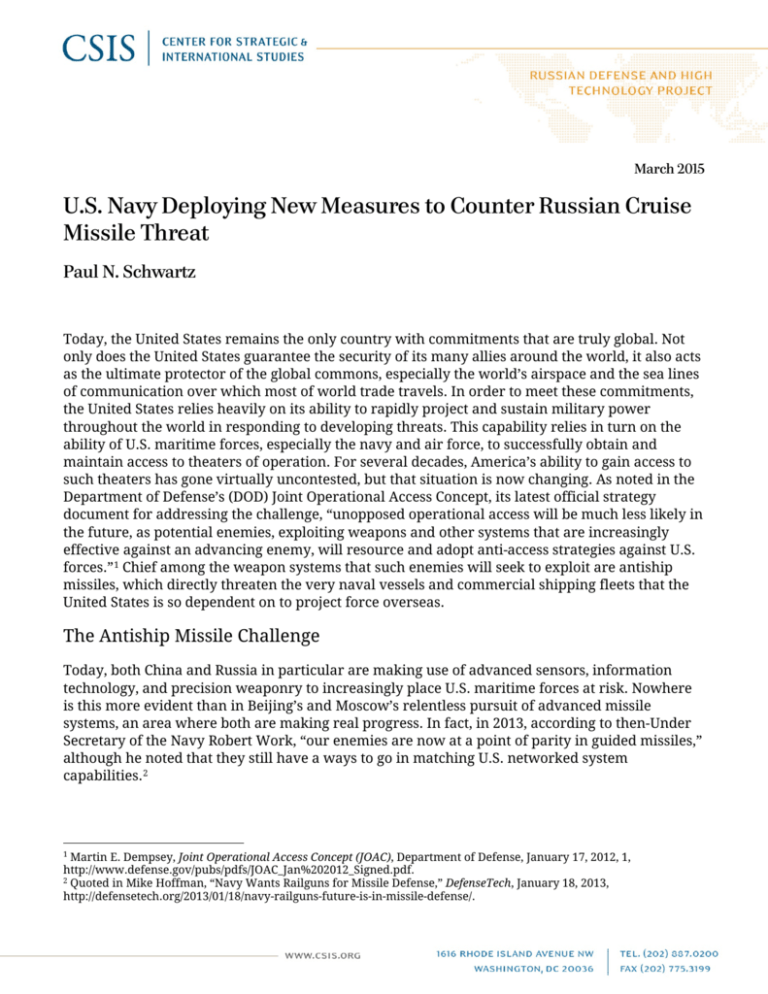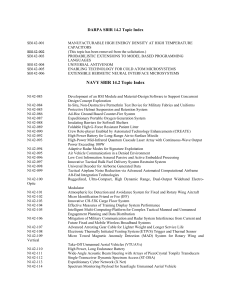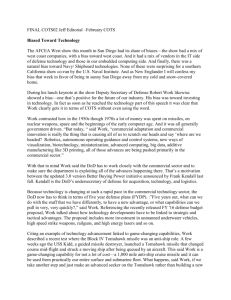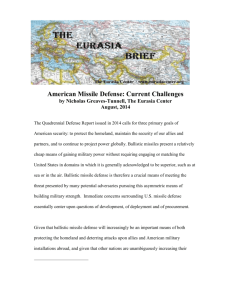
March 2015
U.S. Navy Deploying New Measures to Counter Russian Cruise
Missile Threat
Paul N. Schwartz
Today, the United States remains the only country with commitments that are truly global. Not
only does the United States guarantee the security of its many allies around the world, it also acts
as the ultimate protector of the global commons, especially the world’s airspace and the sea lines
of communication over which most of world trade travels. In order to meet these commitments,
the United States relies heavily on its ability to rapidly project and sustain military power
throughout the world in responding to developing threats. This capability relies in turn on the
ability of U.S. maritime forces, especially the navy and air force, to successfully obtain and
maintain access to theaters of operation. For several decades, America’s ability to gain access to
such theaters has gone virtually uncontested, but that situation is now changing. As noted in the
Department of Defense’s (DOD) Joint Operational Access Concept, its latest official strategy
document for addressing the challenge, “unopposed operational access will be much less likely in
the future, as potential enemies, exploiting weapons and other systems that are increasingly
effective against an advancing enemy, will resource and adopt anti-access strategies against U.S.
forces.” 1 Chief among the weapon systems that such enemies will seek to exploit are antiship
missiles, which directly threaten the very naval vessels and commercial shipping fleets that the
United States is so dependent on to project force overseas.
The Antiship Missile Challenge
Today, both China and Russia in particular are making use of advanced sensors, information
technology, and precision weaponry to increasingly place U.S. maritime forces at risk. Nowhere
is this more evident than in Beijing’s and Moscow’s relentless pursuit of advanced missile
systems, an area where both are making real progress. In fact, in 2013, according to then-Under
Secretary of the Navy Robert Work, “our enemies are now at a point of parity in guided missiles,”
although he noted that they still have a ways to go in matching U.S. networked system
capabilities. 2
1
Martin E. Dempsey, Joint Operational Access Concept (JOAC), Department of Defense, January 17, 2012, 1,
http://www.defense.gov/pubs/pdfs/JOAC_Jan%202012_Signed.pdf.
2 Quoted in Mike Hoffman, “Navy Wants Railguns for Missile Defense,” DefenseTech, January 18, 2013,
http://defensetech.org/2013/01/18/navy-railguns-future-is-in-missile-defense/.
2 | PAUL N. SCHWARTZ
The emergence of increasingly sophisticated antiship cruise missiles (ASCMs) since the end of the
Cold War is an especially worrisome development. The most sophisticated ASCMs achieve
supersonic speeds, are long-range, highly maneuverable, difficult to detect, and very accurate.
Moreover, they are versatile, and can be launched from a variety of platforms, including shorebased missile batteries, manned and unmanned aircraft, and various surface and subsurface
naval vessels. They are designed to penetrate the most sophisticated air defense systems, often
making them suitable for use even when control of the air is lacking. Most importantly, they have
a proven track record of striking important naval targets, dating back to the Falklands conflict in
the early 1980s. Although cruise missile strikes were not always used effectively during that
conflict, Argentine forces did successfully employ a French-made Exocet ASCM to disable the
British destroyer HMS Sheffield, and another was used to sink a container ship. A few years later,
during the Iran-Iraq War, an Iraqi Exocet caused severe damage to the guided missile frigate USS
Stark. Since that time, there have been other successful ASCM strikes as well.3 While these
events took place many years ago, since then, cruise missile technology has advanced rapidly,
prompting many observers to expect these weapons to remain quite effective in future conflicts. 4
For over 50 years, Russia has remained the world’s leading producer of advanced ASCMs. Russia
began developing sophisticated ASCMs during the early Cold War era because it lacked the
conventional naval forces needed to symmetrically counter the U.S. Navy, especially its powerful
carrier task forces. Lacking a large surface fleet, Moscow realized that ASCMs gave it an
asymmetric means to keep U.S. carriers away from the Soviet mainland, preventing them from
mounting large-scale air strikes. With this objective in mind, throughout the Cold War, the
Soviets developed a “large array of large, fast, highly lethal and sophisticated ASCMs.” 5 Soviet
doctrine at least since the 1970s envisioned using long-range land-based maritime aircraft
bearing supersonic air-launched cruise missiles to unleash mass salvo attacks against carrier task
forces at range. 6 Fortunately, the Cold War ended before these capabilities and concepts could be
tested, and during the economic turmoil that followed the Soviet collapse, most Russian ASCM
projects were shelved. Yet progress soon resumed on a limited number of ASCM models, driven
primarily by Russia’s desperate need for export revenues to sustain its defense industry.
One of the most important of these Russian ASCMs is the P-800 Oniks missile (the export version
is known as the Yakhont). The Oniks remains one of the world’s premier ASCMs. It can be
launched from a variety of platforms, including ships, submarines, aircraft, and coastal defense
3 See, for example, Kirk Spencer and Trent Telenko, “An Analysis of the Hezbollah Anti-Ship Missile Strike: The Attack
on the INS Ahi-Hanit,” Behind the News in Israel, July 25, 2006, http://israelbehindthenews.com/an-analysis-of-thehezbollah-anti-ship-missile-strike-the-attack-on-ins-ahi-hanit/4892/.
4 See, for example, Bryan Clark, Commanding the Seas: A Plan to Reinvigorate U.S. Navy Surface Warfare (Washington,
DC: Center for Strategic and Budgetary Assessments, 2014), 12; Dennis M. Gormley, Andrew S. Erickson, and Jingdong
Yuan, A Low-Visibility Force Multiplier: Assessing China’s Cruise Missile Ambitions (Washington, DC: National Defense
University, 2014), 15; Wayne Hughes, Fleet Tactics and Coastal Combat (Annapolis: Naval Institute Press, 2000), 149.
5 Carlo Kopp, “Killing the Vampire,” Defence Today 7, no. 3 (2008), http://www.google.com/url?sa=t&rct=j&q=&esrc=
s&source=web&cd=3&ved=0CCsQFjAC&url=http%3A%2F%2Fwww.ausairpower.net%2FSP%2FDT-Vampires2008.pdf&ei=_XutVOSXNciyggTy8oL4BA&usg=AFQjCNEPGqgloxc2eV_LXHbiJsLCM8-JHw&bvm=bv.83134100,d.eXY.
6 Maksim Y. Tokarov, “Kamikazes: The Soviet Legacy,” Naval War College Review 67, no. 1 (2013): 68–73.
U.S. NAVY DEPLOYING NEW MEASURES TO COUNTER RUSSIAN CRUISE MISSILE THREAT |3
batteries such as the Bastion. 7 The latter was recently installed in Crimea to extend Russian
control over the Black Sea. 8 The Oniks has an effective range of up to 300 kilometers, and can
reach supersonic speeds of up to Mach 2.5, making it one of the fastest ASCMs in the world.
During the terminal phase of its flight, it dips to a sea-skimming altitude of just 5 to 15 meters
above sea level, making it difficult to detect before it strikes the target. The distance at which it
descends to a sea-skimming altitude can be programmed to make it more difficult to counter
depending on circumstances. 9 It employs an active radar seeker, enabling it to hit targets at
extended range once its onboard radar system acquires the target. Moreover, it employs a variety
of countermeasures designed to defeat jamming, spoofing, and deception operations by
electronic warfare systems. The Oniks is designed to be especially effective when fired in salvos,
in which case the missiles are reportedly able to communicate with one another while in flight to
share tracking information and to allocate targets. 10
How Do U.S. Cruise Missile Defense Systems Stack Up?
Since 2000, the U.S. Navy has made substantial progress in upgrading its cruise missile defense
systems to meet the challenge presented by advanced Russian ASCMs like the Oniks. In that year,
a report issued by the Government Accountability Office gave relatively low marks to the Navy
regarding the capabilities of its ship self-defense systems. The report found that “most ships
continue to have only limited capabilities against cruise missile threats.” 11 Nor did the report’s
authors express high confidence that the situation was likely to change any time soon, noting that
“none of the improvements the Navy plans to make in the future would provide any ship class a
high level of self-defense capability against far-term threats.” 12
While this report was limited to an evaluation of ship self-defense systems (as opposed to layered
area defense systems provided by adding aircraft to the mix), there were other significant
problems with the Navy’s cruise missile defense programs at that time. The chief problem was
that the Navy’s ability to detect, target, and intercept incoming cruise missiles at over-the-horizon
(OTH) ranges remained limited. One of the key principles of defending against stealthy, highspeed cruise missiles like the Oniks is early detection. 13 Detection at the greatest possible range
affords the opportunity to take multiple shots at the incoming missile before it reaches its target,
thereby greatly increasing the probability of killing it. Because of the curvature of the earth, a
ship-based radar system cannot readily detect a low-flying cruise missile until it crosses the
horizon and enters the radar’s line of sight. With supersonic missiles like the Oniks, however,
7
Carlo Kopp, “Soviet-Russian Cruise Missiles,” Air Power Australia Technical Report APA-TR-2009-0805, August 2009
(updated January 2014), http://www.ausairpower.net/APA-Rus-Cruise-Missiles.html#mozTocId241813.
8 Nicholas de Larrinaga, Peter Felstead, and Bruce Jones, “Russia Parades Bastion-P in Crimea,” IHS Jane's 360, May 12,
2014, http://www.janes.com/article/37829/russia-parades-bastion-p-in-crimea.
9 Kopp, “Soviet-Russian Cruise Missiles.”
10 See, generally, GlobalSecurity.org, “3M55 Oniks /P-800 Yakhont /P-800 Bolid/SS-N-26,” http://www.globalsecurity.org/
military/world/russia/ss-n-26.htm.
11 U.S. General Accounting Office (GAO), Defense Acquisitions: Comprehensive Strategy Needed to Improve Ship Cruise
Missile Defense (Washington, DC: GAO, July 2000), 4, http://www.gao.gov/assets/230/229270.pdf.
12 Ibid.
13 Dennis M. Gormley, Dealing with the Threat of Cruise Missiles (Hoboken: Taylor and Francis, 2013), 59–60.
4 | PAUL N. SCHWARTZ
waiting until then to engage the target leaves little time for the ship’s defensive systems to
effectively react before the missile strikes.
Of course, the Navy has long been using airborne radar systems, like the E-2 Hawkeye, to expand
its defensive coverage area. Because of their greater perspective, airborne radars on high-flying
aircraft like the E-2 can detect incoming missiles at much greater range. Once the incoming
missile is detected, the E-2 can cue (i.e., relay) information to both in-flight aircraft capable of
intercepting it as well as ships that lie in its flight path. This capability has long enabled the Navy
to mount a defense in depth against incoming cruise missiles. Aircraft equipped with lookdown/shoot-down radar flying in the outer perimeter constitute the first line of defense. 14 Any
missiles that leak through that outer defense zone could then be targeted by ship-borne missile
defense systems located in the inner zone.
Despite the increased coverage provided by a layered defense system, this approach suffers from
shortcomings. First, maintaining an area defense system requires a relatively large number of inflight aircraft to remain on station at all times, which is not only costly, but greatly increases the
wear and tear on pilots and equipment. Second, even with extended coverage, patrolling aircraft
cannot be everywhere at the same time. So even when a target is spotted by an E-2, the closest
interceptor still has to rapidly close to within striking distance of the incoming missile in order
for its onboard radar system to acquire the target and to engage it with its own antimissile
defense systems. Likewise, ship-borne missile defense systems covering the inner defensive zone,
such as the Aegis combat system, have until recently been unable to engage incoming cruise
missiles until they have already penetrated the outer defense zone. Because ship-based missiles
like the Standard Missile-2 (SM-2) require ship-borne radar systems to provide the necessary
guidance, they could only operate within the radar’s line of sight. Thus, even with a layered
defense system, ship-borne missile defense systems still could not engage an incoming cruise
missile at OTH ranges.
Due to the Navy’s deployment of new systems over the last several years, however, OTH
engagement capabilities have improved substantially. Such systems include the ship-based Aegis
Combat System, the Cooperative Engagement Capability (CEC) system, the Standard Missile-6
(SM-6), and associated radar systems. Collectively, the component systems constitute elements of
the new Naval Integrated Fire Control-Counter Air (NIFC-CA) “system of systems.” The first of the
new component systems to be deployed was the CEC. With CEC, radar systems and sensors
distributed across a variety of aerial and naval platforms can now be networked together to
provide for sharing of radar surveillance and tracking data. 15 Through CEC, each platform now
receives an integrated picture of the entire battlespace, and consequently no longer has to rely
on its own limited perspective. Thus CEC provides the first essential step toward enhanced OTH
targeting, locational awareness, and tracking of enemy targets beyond the horizon.
14
Michael S. Perkins, “Joint Counterair and Theater Missile Defense Doctrine to Defend against Unmanned Aerial
Systems and Cruise Missiles in Asymmetric Warfare” (research report, Air War College, February 2009),
http://www.dtic.mil/cgi-bin/GetTRDoc?AD=ADA540426.
15 Tom Druggan, “Sensor Network Helps Clear ‘Fog of War,’” National Defense 85, no. 571 (June 2001): 36.
U.S. NAVY DEPLOYING NEW MEASURES TO COUNTER RUSSIAN CRUISE MISSILE THREAT |5
Even with CEC, however, OTH targeting continued to suffer from other limitations. Locating and
tracking the target is only half the battle; it also has to be successfully engaged and destroyed at
OTH ranges as well (a concept known as “engage on remote”). Until recently, the Navy’s ability to
do so was limited by the semi-active radar seekers on board ship-launched missiles, such as the
SM-2. Such missiles depend upon ship-borne radar systems to properly illuminate the target
(here, the incoming ASCM) so that the missile can home in on the reflected radar signal. But shipborne illuminators can only do this once the cruise missile has come within its radar’s line of
sight. Therefore, despite early detection, a low-flying cruise missile could still approach
uncomfortably close to a targeted ship before it could be engaged by the SM-2. 16 Until this
problem was solved, the capability to intercept cruise missiles at OTH ranges would remain
limited.
To remedy this problem, the Navy developed the new SM-6. Unlike the SM-2, the SM-6 is
equipped with an active radar seeker. Using active radar, the SM-6 can acquire and track the
target itself once it has flown to within radar range of the incoming cruise missile. Consequently,
with active radar, the SM-6 no longer depends on ship-borne radar systems to illuminate the
target. While the SM-6 must still be guided to within range of the targeted missile before its
onboard radar can take over, this can be accomplished “by using networked fire control data
such as that provided by the Navy's [CEC].” 17 With CEC, the ship that launched the missile
continues to communicate with the SM-6 during its midcourse phase to provide updated
guidance information until the SM-6’s active radar system can take over. 18 In July 2014, an SM-6
using this approach successfully intercepted a “cruise missile target . . . at near the missile’s
maximum range.” 19 Thus, the SM-6, with its extended range and active radar capability, provides
the final piece needed to conduct successful OTH engagement of incoming cruise missiles,
currently at ranges of up to 130 nautical miles.
Conclusion
While the Navy’s new capabilities represent tremendous progress in countering advanced
ASCMs, it is not yet clear how well they will perform against the most sophisticated Russian
ASCMs. In addition to the Oniks, the Russians have also deployed the highly capable Klub missile.
Supplementing its versatility, range, and low profile, the Klub also has the unique ability of first
approaching its target at subsonic speed, and then accelerating rapidly to speeds of up to Mach
3.0 as it makes a final sprint to the target.
The United States and its allies would likely encounter such missiles in theaters other than just
Crimea. In a future conflict involving Russia, for example, ASCMs could conceivably be used in
16
GlobalSecurity.org, “RIM-174 SM-6 Extended Range Active Missile (ERAM),” http://www.globalsecurity.org/
military/systems/munitions/sm-6.htm.
17 Ibid.
18 GlobalSecurity.org, “Navy Programs: Standard Missile-6 (SM-6),” http://www.globalsecurity.org/military/library/
budget/fy2012/dot-e/navy/2012sm-6.pdf.
19 PRNewswire, “SM-6 Destroys Longest Range Cruise Missile to Date,” MissileThreat.com, July 15, 2014,
http://missilethreat.com/sm-6-destroys-longest-range-cruise-missile-target-to-date/.
6 | PAUL N. SCHWARTZ
the Baltic Sea, in the Arctic, and off Russia’s Pacific Coast. Moreover, the Russians have exported
sophisticated ASCMs to other countries, including China, Syria, Indonesia, and possibly
Venezuela, among others. Thus, the United States may find itself targeted by Russian ASCMs in a
variety of other theaters as well. Nor do Russian ASCMs constitute the exclusive threat. Many
other states, including China and Iran, are developing sophisticated antiship missiles of their
own. Some of these, such as China’s new Dong-Feng 21D antiship ballistic missile, will pose
unique challenges for NIFC-CA, especially when used in conjunction with traditional ASCMs.
Moreover, Russian doctrine today, as during the Cold War, likely still calls for undertaking
sustained, mass-salvo attacks from multiple directions against U.S. naval battle groups, in the
hopes of overwhelming U.S. missile defense systems, no matter how capable they may be at
countering small numbers of incoming cruise missiles. China has clearly adopted a similar
approach. Finally, new Russian cruise missile programs threaten to reverse some of the gains
made by the United States in deploying OTH technology. For example, new Russian missiles will
be stealthier (making them harder to detect at long range) and faster (eroding some of the gains
in reaction time achieved through OTH capabilities). 20 Thus, the Navy will not have much respite
before it has to address a whole new set of ASCM challenges. In fact, the Navy is already working
on new measures to counter further advances in cruise missile technology, including use of
satellites and aerostats (tethered balloons) to enhance detection and tracking capabilities, and
use of electromagnetic railguns and high-energy lasers to improve intercept capabilities.
Paul N. Schwartz is a nonresident senior associate with the Russia and Eurasia Program at the
Center for Strategic and International Studies in Washington, D.C.
This report is produced by the Center for Strategic and International Studies (CSIS), a
private, tax-exempt institution focusing on international public policy issues. Its research
is nonpartisan and nonproprietary. CSIS does not take specific policy positions.
Accordingly, all views, positions, and conclusions expressed in this publication should be
understood to be solely those of the author(s).
© 2015 by the Center for Strategic and International Studies. All rights reserved.
20 Gormley, Dealing with the Threat of Cruise Missiles, 59; and National Air & Space Intelligence Center (NASIC), Ballistic
and Cruise Missile Threat, NASIC-1031-0985-09 (Wright-Patterson AFB, OH: NASIC, April 2009), http://fas.org/irp/
threat/missile/naic/NASIC2009.pdf.








